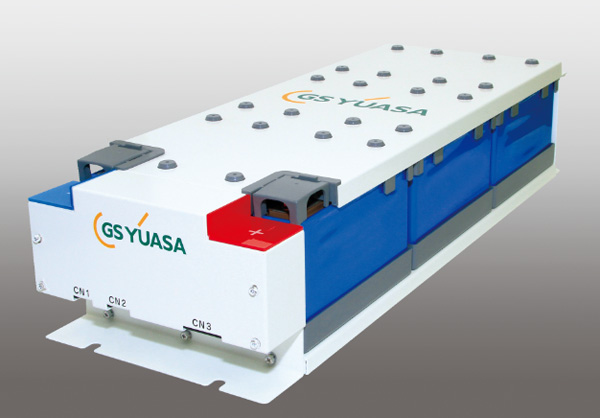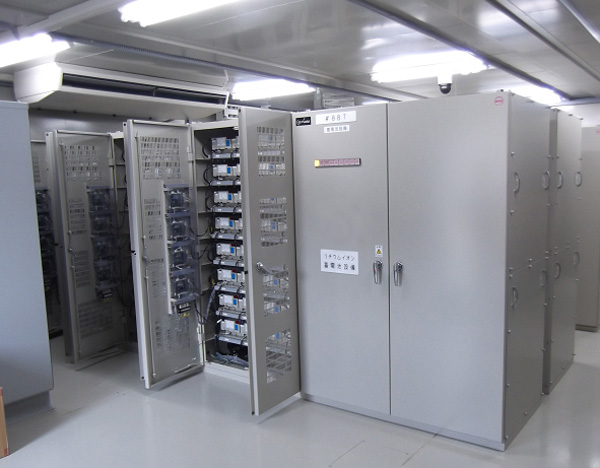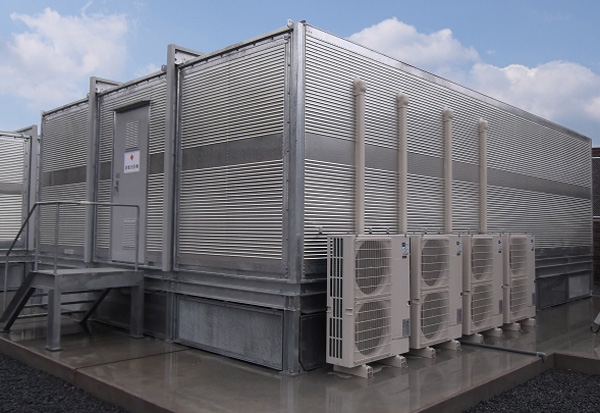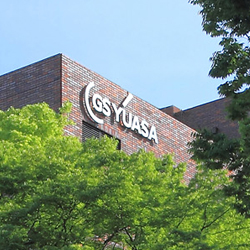GS Yuasa (Tokyo Stock Exchange: 6674) announced today that its lithium-ion battery system has been installed at testing facilities in Iki City, Nagasaki Prefecture designed to study the optimal methods to use storage batteries to control power system frequency fluctuation on remote islands. The system was constructed by Mitsubishi Electric Corporation (Tokyo Stock Exchange: 6503) for Kyushu Electric Power Co., Inc. (Tokyo Stock Exchange: 9508), and has been operating successfully at the power company’s Ashibe substation in Iki City since March 2013. The tests are scheduled to continue through fiscal 2014. The lithium-ion battery system is being used to charge and discharge power during periods when power generation from wind, solar and other renewable power sources changes suddenly, thereby stabilizing the amount of power delivered to the power grid and controlling the system’s frequency fluctuation.
The lithium-ion battery system installed at the testing facilities comprises eight storage battery units, housing 96 LIM50E modules. The entire system is housed within two storage battery enclosures measuring 10 meters wide by 7 meters deep.
Feasibility tests and installation studies on providing stable supplies of renewable energy are progressing in Japan and many countries around the world. Lithium-ion batteries have been recognized as key devices for stable power supply, and the expanded usage of renewable energy sources will require safe, low-cost lithium-ion batteries with superior performance. GS Yuasa is actively collaborating on the Iki City tests and other studies with the aim of contributing to the effective use of renewable energy and lowering the environmental burden through the supply of superior storage batteries.
Lithium-ion Battery System Characteristics
1 ) Configured for DC high voltage (800V rated) power conditioner system (PCS)
2 ) Integrated battery management unit (BMU) provides centralized management of multiple battery banks (6 in parallel, 1,152 cells)
3 ) System volume is reduced by 12% and system mass is reduced by 17% compared with previous GS Yuasa systems
4 ) Voltage and capacity are easily customized through the combination of multiple modules connected in series and parallel
5 ) Independent control of each unit enables maintenance to be conducted without interrupting system operation
6 ) Storage batteries are completely separated from the circuit breaker and other electric parts by steel plates (housed in cubicles that conform to fire prevention ordinances)
7 ) Utilizes a redundant power supply and a multi-system controller
| Module type | LIM50E-12G2-C2 (12-cell modules) |
|---|---|
| Number of batteries | 9,216 cells (8 units, each comprising 16 modules connected in series and 6 modules in parallel) |
| Capacity (kWh) | 1,616 (202 x 8 units) |
| Nominal voltage (V) | 710.4 |
| Dimensions (mm) | W4800 x D850 x H2050 (per unit) |
| Mass (kg) | Approx. 4,600 (per unit) |
| Cooling system | Self-cooling |
■1.Lithium-ion battery module: LIM50E-12G2-C2 (12-cell modules)

■2. Lithium-ion battery system

■3. Storage battery enclosure






